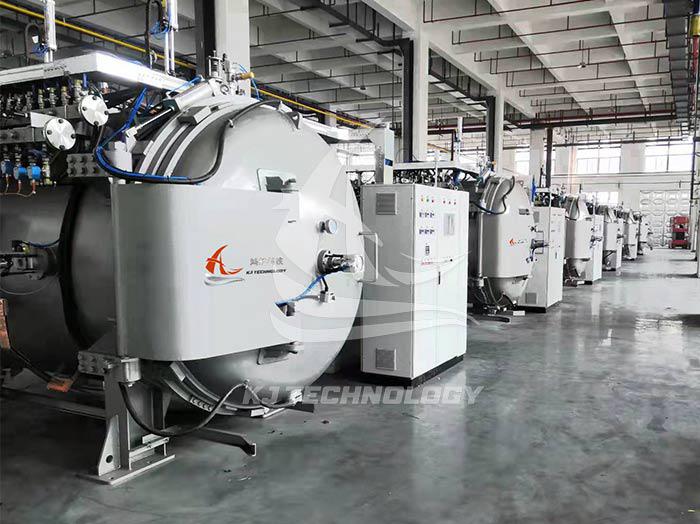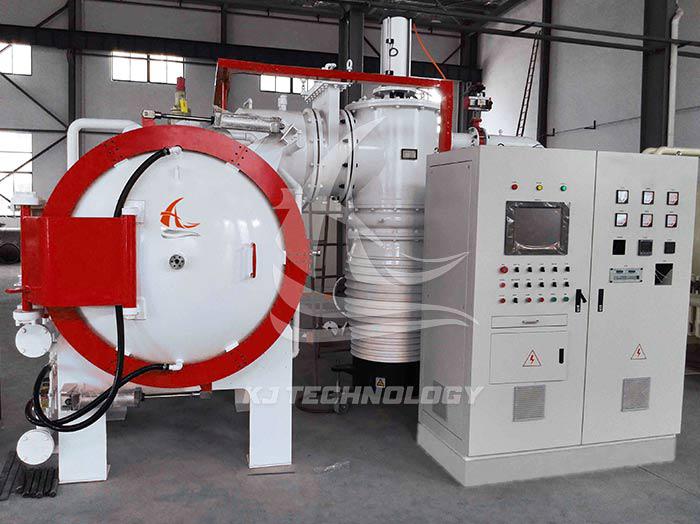Characteristics of large-sized furnace vacuum heat treatment furnace
 09-29-2025 Author: KJ technology
09-29-2025 Author: KJ technology
The large-sized furnace vacuum heat treatment furnace combines vacuum environment and large-sized processing capability, demonstrating unique advantages in the field of material processing. Its characteristics can be summarized into five dimensions: structural design, performance indicators, process control, safety and environmental protection, and economy, as follows:
1. Structural design features
Large scale furnace design
The furnace volume is significantly larger than conventional equipment, and can accommodate large workpieces (such as aircraft engine blades, automotive crankshafts) or small batches of workpieces, reducing the number of batch processing times and improving production efficiency.
The furnace structure adopts modular design, which is easy to maintain and upgrade, such as quick replacement of heating elements or insulation layers.
Multi layer insulation and efficient heating
The inner wall of the furnace adopts multi-layer composite insulation materials (such as molybdenum plate, graphite felt, ceramic fiber) to reduce heat loss and energy consumption.
Optimization of heating element distribution, combined with zone temperature control technology, ensures temperature uniformity within the furnace (within ± 5 ℃) and adapts to the heat treatment needs of different workpieces.
High strength vacuum seal
The furnace door and body are sealed by a double-layer water-cooled structure and silicone ring extrusion, with a cold vacuum degree of up to 10 ⁻ Pa and stable sealing performance during long-term operation.
Key components such as observation windows and electrode interfaces are designed with special sealing to prevent vacuum leakage.
2. Characteristics of performance indicators
Ultra high vacuum degree
By combining a mechanical pump (rotary vane pump) with a molecular pump (or diffusion pump), the ultimate vacuum degree can reach 10 ⁻⁴ Pa, much lower than atmospheric pressure (10 ⁵ Pa), effectively suppressing reactions such as oxidation and decarburization.
Low pressure rise rate, meeting the requirements of precision material processing.
Wide temperature range and high-precision temperature control
The temperature range covers room temperature to 1600 ℃ (some models can reach 2500 ℃), suitable for various material heat treatment needs.
Adopting PID intelligent microcomputer control, combined with thermocouple or infrared temperature measurement technology, the temperature control accuracy is ± 1 ℃, and the temperature fluctuation is small.
Rapid temperature rise and fall capability
In a vacuum environment, there is no convective heat dissipation, and the heating efficiency is higher than that of an air furnace, which can achieve rapid heating (such as 0-20 ℃/min).
Equipped with a high-pressure gas quenching system (up to 15 bar), the cooling rate is higher, reducing workpiece deformation.
3. Characteristics of process control
Multi process compatibility
Support all heat treatment processes such as quenching, annealing, tempering, carburizing, nitriding, brazing, sintering, etc., to meet the processing needs of complex materials.
It can integrate partial pressure control function, adjust the furnace atmosphere by filling with gases such as argon and hydrogen, and adapt to different material reaction requirements.
Automation and Intelligence
Equipped with industrial precision 0.2 level intelligent instruments, supporting multi-stage program temperature control (such as 16 pre stored sintering processes), simplifying the operation process.
Integrated safety functions such as over temperature protection, thermocouple warning, and leakage protection ensure high operational stability of the equipment.
Traceability of process parameters
Record the temperature, pressure, time and other parameters of the entire heat treatment process, generate traceable process reports, and comply with industry standards such as aerospace and automotive.
4. Safety and environmental characteristics
Multiple security protections
The furnace structure has high strength and can withstand internal pressure changes to prevent explosion risks.
Equipped with emergency stop button and gas leak alarm device to ensure the safety of operators.
Non polluting emissions
The vacuum environment does not require the treatment of oxide scale or quenching oil smoke, and the working environment is clean, meeting the requirements of green manufacturing.
Exhaust gas treatment systems, such as molecular pump exhaust filtration, can further reduce harmful substance emissions.
5. Economic characteristics
Reduce material loss
A non oxidizing environment reduces the thickness of the oxide layer on the surface of the workpiece (such as carbon steel decarburization layer ≤ 0.01mm), and improves material utilization.
Reduce subsequent polishing, acid washing, and other processes to lower processing costs.
Improve product quality
After vacuum treatment, the material properties are more stable and the product qualification rate is significantly improved.
Suitable for high value-added products such as aircraft engine blades and medical equipment, to enhance market competitiveness.
Energy-saving design
The waste heat recovery system uses the heat from the cooling gas to preheat the workpiece, reducing energy consumption.
Efficient insulation materials reduce heat loss and further lower operating costs.








